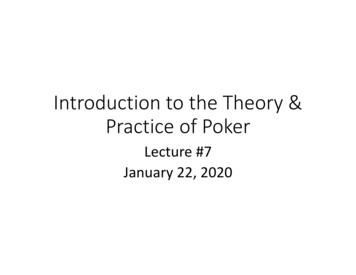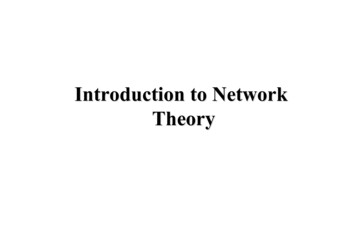
Transcription
Introduction to the Theory &Practice of PokerLecture #7January 22, 2020
Last night’s tourney 192 players enteredLasted over 4.5 hoursBelow 100 players after one hour22 students qualified for Thursday Qualifiers, please stand up Special mention: Joe Carrigan Security Institute staff Final table, please stand up! Winner: Sidney Thybulle Tonight’s satellite 21 new students will qualify Starts at 7:00 pm (10 minute late entry allowed)
Cash game survey One day left to collect chips
Guest speaker:
Shortcut you must know
Very important rules of thumb Rule of Four If 2 cards are still to come, and you will see both cards, multiply your outs byfour to get your winning chances in the hand. For example, if you have 6 outs on the flop, you have a 24% chance of winning Approx 3-to-1 against So any pot odds better than 3-to-1 is a call Rule of Two If only one card is still to come, multiply your outs by two to get your winningchances For example, if you have nine outs on the River, you have an 18% chance of winning More accurate rule of Four (if more than 8 outs) With 2 cards to come, multiply outs by four, then subtract number of outs inexcess of 8 to get winning percentage For example, if you have 14 outs, your chance of winning is 14 x 4 – (14– 8) 56 – 6 50%
Converting percentage to Odds against These shortcuts give you a percentage Need to convert to odds against to compare to pot odds Say we have 12 outs on the turn 24% chance of winning Divide 100 by the percentage: 100/24 4 (approx.) Subtract 1 from the result 4–1 3 Odds against 3-to-1
Problem On the Turn, the board is: Your opponent has:you have: There is 200 in the pot, and opponent goes all in for 100 What would you do? Use rule of 2 to figure out your winning percentage: Outs: 4 eights, 2 sixes, 3 nines, total: 99 x 2 18% (round up to 20 – if doing in your head)Convert to odds against, 100/20 - 1 5 – 1 4-to-1 (slightly higher due to rounding)Calculate pot odds: 100 to call, and 300 in the pot after his bet. 3-to-1 Pot odds Fold!
Problem On the Flop of Your opponent has:you have: There is 200 in the pot, and opponent goes all in for 200 Use rule of 4 to figure out your winning percentage: Outs: 4 Tens, 3 Aces, 3 Queens, 8 spades (why not 9?), total: 1818 x 4 – 10 62%Convert to odds against, 100/62 1.6 – 1 0.6-to-1Calculate pot odds: 200 to call, and 400 in the pot after his bet. 2-to-1 Pot odds Easy call! Common sense also says always call with 18 outs. You’re favored.
Poker Moves
Stop ‘n Go You are low on chips in a tournament, say 10 big blinds You should be going all in soon A player in middle position raises, and you are in the big blind You could shove here But instead: You call the raise And then shove the flop no matter what 70% of the time he misses the flop Possibly a better chance of winning than initial shove
First in bluff Heads up: 70% of the time, the flop misses both players Whoever bets first has a big advantage Even multi-way, if nobody takes an interest in the pot Often first aggressor wins If you don’t take it down You take the initiative And can bluff on later streets Pay attention See who is always stabbing at the pot Play back at them If nobody seems to want the pot, then you take the stab
The float You are in position Not a good move to make out of position Opponent raised pre-flop, and you called Say your hand is And the flop comes Your opponent leads out with a continuation bet Consideration: You think he would C-bet almost any flop He is an ABC player
Your handThe float More considerations You are probably behind Odds are he did not improve on this flop The move You call Not calling for value Calling to steal this later in the hand If the turn is a low card or pairs the board If he checks, you bet He’ll fold most of his high card handsFlop:
Floating Conditions for floating Heads upPlayer likes to C-bet a lotYou are in positionYour table image is solidPlayer is straightforward and will only take one stabYou are ready to fold if your subsequent bet is raised big When not to float Out of positionMulti-way potYou have a loose table imageYou are up against a rock Give his C-bet more credit Multiple players in the hand More advanced/risky two-street float
The Squeeze How it works: You are on the buttonAn aggressive player in middle position who opens often raises 3BBA straightforward player to his left callsAction is to youYou put in a good solid raise with garbage
Squeeze example 2- 5 game Stacks are 500 3rd position player makes it 20 He is a LAG and raises all the time in unopened pots 5th position player calls He is a TAG, boring regular player, not creative You are on the button with There is 47 in the pot You make it 125 to go
Your hand:Squeeze example Folds around to original raiser He has a wide range of hands He will be out of position on the flop He faces another player behind him Thus, he is ”squeezed” between you and that player Your bet is very big He will fold most of the hands he raised with So original raiser folds, and action is to the caller He had a hand that called but did not raiseSo, rule out most of the strongest holdingsHe is a solid, regular, and not likely to go to war with average handHe will usually fold
Your hand:Squeeze example Even if one of them calls, now you have a nice pot And you can C-bet and take it down on the flop In this example, say one of them calls you flop comes Opponent checks to the raiser You Bet 150 and he folds The A on the flop gave you a good card to bluff
Conditions for a Squeeze First player opens a wide range and is a decent player Will fold to a big raise if he is weak Second player is straightforward and not too tricky Call means what it looks like Careful if he is a trappy player You have a solid table image Not viewed as too wild You have not squeezed in a while if at all Can’t get away with this play too often It is pretty obvious
Warning about squeeze play It is the most common move Even inexperienced players are familiar with it Anytime there is a raise and just a call followed by a big raise People will suspect a squeeze Exploit this by pretending to squeeze with huge hands Rather than a normal raise on the button, put in a bigger raise If you look like you’re squeezing, you might get re-raised Be on the lookout for squeeze plays OK to play back at them sometimes with a raise But be confident or have a good hand
Very important rules of thumb Rule of Four If 2 cards are still to come, and you will see both cards, multiply your outs by four to get your winning chances in the hand. For example, if you have 6 outs on the flop, you have a 24% chance of winning Approx3-to-1 against So any pot odds better than 3-to-1 is a call Rule of Two











